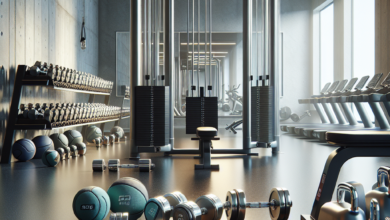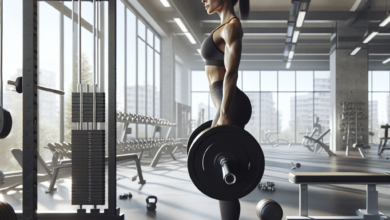What Is ‘Y Raise’ Exercise? Discover the Benefits!
The Y Raise is a dynamic exercise that targets the muscles in your shoulders, specifically the posterior deltoids, which play a crucial role in achieving that broad, sculpted shoulder look. This movement also engages the upper back and rotator cuff muscles, strengthening your shoulder girdle and improving overall shoulder health and stability. By practicing the Y Raise, you can enhance your posture and shoulder mobility, making it a valuable addition to any fitness enthusiast’s workout routine.
Perfecting the Y Raise requires attention to form and technique to maximize its benefits and reduce the risk of injury. As you incorporate this exercise into your regimen, you’ll find that it complements other shoulder exercises and contributes to a balanced upper-body workout. Whether you’re a seasoned athlete or just starting your fitness journey, the Y Raise is a versatile exercise that can be adjusted to suit your current fitness level.
Curious to learn more about how to incorporate the Y Raise into your workout routine? Explore More at Muscle Theory where you’ll find detailed guidance on form, variations, and the science behind this effective shoulder exercise.
Anatomy of the Y Raise: Targeted Muscle Groups

The Y Raise is a compound exercise that engages multiple muscle groups, primarily focusing on the shoulder region. The primary muscle worked during this exercise is the posterior deltoid, which is the rear part of the shoulder muscle. It plays a significant role in shoulder abduction, transverse extension, and external rotation. The Y Raise also activates the middle deltoids and, to a lesser extent, the anterior deltoids, contributing to the rounded shape of the shoulder.
Additionally, the exercise involves the upper trapezius and levator scapulae, which assist in elevating the shoulder blades. The rotator cuff muscles, including the supraspinatus, infraspinatus, teres minor, and subscapularis, are also engaged. These muscles work synergistically to stabilize the shoulder joint throughout the movement. Moreover, the rhomboids and serratus anterior are involved, aiding in scapular retraction and protraction, respectively.
Given the involvement of these stabilizing muscles, the Y Raise not only builds shoulder strength but also enhances shoulder stability and mobility. This makes it an ideal exercise for individuals looking to improve their upper body functional strength and those aiming to prevent shoulder injuries.
Step-by-Step Guide to Proper Y Raise Form
Executing the Y Raise with proper form is crucial for maximizing its benefits and minimizing the risk of injury. Begin by standing with your feet shoulder-width apart, holding a pair of light dumbbells with your palms facing each other, arms by your sides. This will be your starting position.
Step 1: Engage your core and keep your back straight. Inhale as you raise the dumbbells up and out to the sides, keeping a slight bend in your elbows. Your arms and body should form a ‘Y’ shape as you lift the weights.
Step 2: As you lift, focus on leading with your thumbs, rotating them slightly outwards. This slight external rotation engages the rotator cuff and ensures maximum involvement of the shoulder muscles.
Step 3: Elevate your arms until they are in line with your body, being careful not to shrug your shoulders. The movement should be smooth and controlled, avoiding any jerking motions.
Step 4: Hold the position briefly at the top of the movement, focusing on squeezing your shoulder blades together gently to activate the upper back muscles.
Step 5: Exhale as you slowly lower the dumbbells back to the starting position, maintaining control throughout the descent.
Repeat the exercise for the desired number of repetitions, typically between 8 to 12 for muscle growth. It’s important to choose a weight that allows you to perform the exercise with strict form without overstraining your muscles.
Variations and Progressions of the Y Raise

To prevent plateaus in strength gains and keep your workouts dynamic, it’s essential to incorporate variations and progressions into your Y Raise routine. Here are a few options to consider:
- Incline Y Raise: Perform the Y Raise lying face down on an incline bench. This variation increases the range of motion and intensity of the exercise, targeting the shoulders and upper back muscles more effectively.
- Resistance Bands Y Raise: Using resistance bands instead of dumbbells can provide continuous tension throughout the exercise, challenging your muscles in a different way. Stand on the band and hold the other end with your hands to perform the raise.
- Single-Arm Y Raise: Execute the Y Raise with one arm at a time to focus on each shoulder individually. This unilateral movement can help address muscle imbalances and improve overall shoulder stability.
- Y Raise with External Rotation: After raising the arms into the Y position, add an extra step by rotating the shoulders externally, moving the hands backward. This progression targets the rotator cuff muscles more intensely.
As you become more comfortable with the standard Y Raise, these variations can help you to continue developing shoulder strength and stability. Remember to keep the weight manageable, especially when trying new variations, to maintain proper form and avoid injury.
Progression should also be gradual, increasing the weight or resistance only when you can perform the current level with ease. This approach ensures continuous improvement while keeping your workouts safe and effective.
Incorporating the Y Raise into Your Workout Routine
Effectively integrating the Y Raise into your workout regimen can enhance shoulder development and improve posture. To get the most out of this exercise, consider the following tips:
- Warm-Up: The Y Raise is excellent for warming up your shoulders before engaging in heavy lifting or pressing movements. Performing light Y Raises can increase blood flow to the shoulder region and prepare the muscles and joints for more demanding exercises.
- Superset: Pairing Y Raises with another exercise can maximize your time in the gym. Try supersets with exercises that target different muscle groups, such as chest presses or pull-ups, to keep your workout balanced and efficient.
- Recovery Days: Incorporate Y Raises on recovery or light training days. Since they are a low-intensity movement, they’re perfect for active recovery and can help maintain shoulder mobility and health without overtaxing the muscles.
- Shoulder Workouts: Include Y Raises as part of your dedicated shoulder routine. When combined with overhead presses, lateral raises, and front raises, they contribute to a comprehensive approach to shoulder training.
For beginners, starting with two sets of 10 to 12 repetitions is a good baseline. As you progress, increase the volume and intensity gradually. Remember to focus on the quality of movement over quantity; controlled, deliberate motions will yield the best results and reduce the risk of injury.
By thoughtfully incorporating the Y Raise into your fitness routine, you can build stronger, well-defined shoulders and a more resilient upper body.
Maximizing Recovery and Results Post-Y Raise
After completing your Y Raise sets, it’s crucial to focus on recovery to maximize your results and prepare your muscles for the next workout. Here are strategies to enhance recovery post-Y Raise:
- Stretching: Engage in static stretches targeting the shoulder girdle to alleviate tension. Hold each stretch for 15-30 seconds to improve flexibility and reduce the risk of muscle tightness.
- Hydration: Replenish fluids lost during your workout. Drinking water or an electrolyte solution helps in muscle recovery and maintains hydration levels.
- Nutrition: Consume a balanced meal with an appropriate ratio of protein to carbohydrates. This aids in muscle repair and replenishment of glycogen stores.
- Rest: Ensure adequate rest between shoulder workouts. Overworking the muscles without sufficient rest may hinder recovery and growth.
- Massage or Foam Rolling: Implement self-myofascial release techniques to reduce soreness and enhance blood flow to the worked muscles.
By adhering to these recovery principles, you ensure that your muscles recuperate efficiently, paving the way for consistent improvement and fewer injuries. Remember, recovery is just as important as the workout itself for building strength and muscle.
Ready to take your shoulder training to the next level? Explore More at Muscle Theory for advanced tips, nutrition advice, and the latest workout trends to keep your fitness journey on track.



